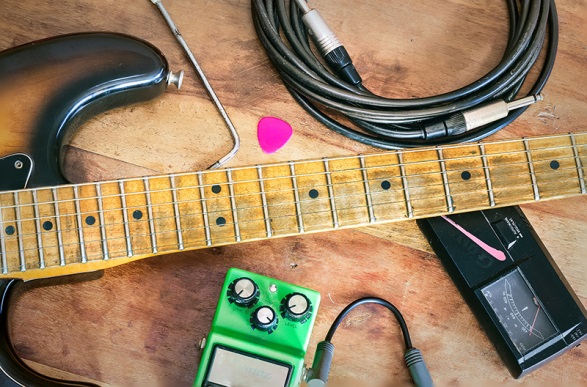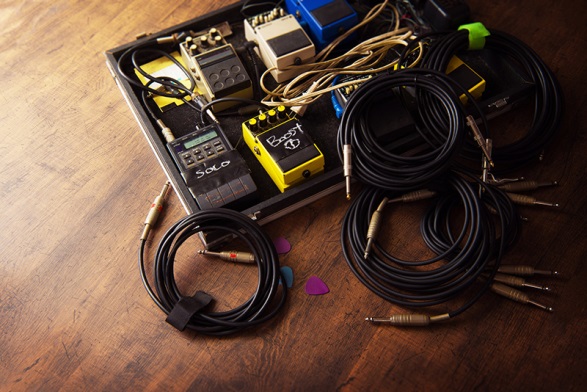 We’d like to introduce and welcome a guest blog from Natalie over at MusicalAdvisors.com. She has some tips to offer for those interested in using guitar effects. Consider these a good starting point for readers looking for introductory advice – DS
We’d like to introduce and welcome a guest blog from Natalie over at MusicalAdvisors.com. She has some tips to offer for those interested in using guitar effects. Consider these a good starting point for readers looking for introductory advice – DS
Guitar effect pedals are an excellent way to take your music to the next level by adding texture, volume, resonance, or modulation effects. The best guitarists in history, such as Hendrix and Van Halen, have made effect pedals a staple for all rock styles of music. As a musician myself, I’ve learned the ideal way to organize my pedals on a pedalboard through years of trial and error. If you’re looking to create a pedal chain to make your music more complex, there are a few basic principles you can follow to optimize your sound.
Here are some tips to help you chain your effects pedals:

#1) Know your pedals There are a few different categories of effect pedals, and understanding the function of each will make your chain-building process much easier. Each type of pedal is unique and will require some experimentation on your part to understand its nuances, but there are some general characteristics of each type.
For example, tuner pedals don’t have an audible effect on your sound. Instead, they’ll simply tell you how in tune you are with a visual indicator. Filter and compressor pedals will balance out your sound which may soften certain spikes in your signal, and gain pedals will, in contrast, provide that extra power so common in rock music. Modulation pedals will then affect the amplitude, frequency, or the phase of your music. Finally, delay and reverb pedals will create resonance via echo effects.
#2) Clean signal for tuner pedals
Tuner pedals are great investments for guitarists who need to tune their guitar frequently when they’re on stage in a loud performance venue. Using traditional digital tuners in these settings can be problematic because of the noise that comes along with a large audience. Purchasing a tuner pedal will prevent you from having any issues while you’re on stage. Just make sure you’re sending a clean signal into your tuner pedal, which means it should go at the very beginning of your chain.
#3) Volume before modulation
Any volume pedals you’re planning on inserting in a chain usually go before your distortion and modulation pedals. This will give you much more control over your final output sound. Pedals that will affect your volume include boost, volume, and EQ pedals. Even though compressor pedals often soften the volume by suppressing spikes in your signal, they should also still be included in the volume category. Many guitarists view compressor pedals as necessary for producing a well-rounded sound, even though their effects are so subtle.
Before you start experimenting with distortion or modulation pedals, make sure you have those uncontrolled buzzing noises and spikes in your signal addressed by turning on your filter pedals. If you don’t place these pedals first, you might hear those spikes become even more dramatic by the pedals in your distortion section.
#4) Tone before modulation
It’s also important to establish your tone before you begin adjusting the pitch, phrasing, or timing or your sound. Imagine your pedal chain as a pyramid. The most important foundational sounds should go on the bottom (or, in this case, at the beginning of the pedal chain). Before you start shifting the pitches of your audio signal, make sure you like the quality of those pitches first. If you aren’t happy with the foundations of your tone, then modulating that sound will only make the elements you aren’t happy with more apparent.
#5) Reverberance last
Finally, time-based effect pedals will usually go at the end of your pedal chain. These pedals include delay pedals, which will create an echo effect, and reverb pedals, which create the illusion of a certain acoustic setting. Both of these pedals are similar because they add more depth to your sound, but their approaches are different. If you’re hoping to create and fine tune an echo by adjusting the timing and number of repeats, then you should probably invest in a delay pedal. If your goal is to produce the feeling of playing in a cathedral or concert hall, then be sure to read more about the best reverb pedals on the market. Establish your preferred sound first with your other pedals and then add an echo. If you don’t, any sound elements you aren’t happy with will only be emphasized by that repeat.
In Conclusion 
Hopefully, these principles will help you create a sophisticated pedal chain to optimize your music. Remember that these principles are simply suggestions, and many innovative guitarists often broke these “rules” in order to create a sound that suited their tastes.
I’d recommend building your pedal chain by following these principles first, but then experimenting to figure out your ideal placement. For example, try switching your order so that your boost pedal comes at the end of the chain, right before the amplifier. By doing so, you’ll likely hear much more presence in your sound. If you want a more in-depth explanation of how to set up a pedal chain effectively, take a look at this tutorial.
About me:
 |
Hi everyone!
I’m Natalie. I work as a professional musician, session guitarist, and guitar teacher, and would like to use my blog as a personal outlet to share my six-string knowledge with the world. Visit my blog: MusicalAdvisors.com Contact me: [email protected]
|